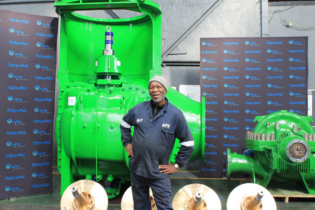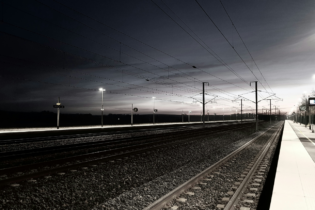Pictured: The recently installed hydroelectric energy generation technology
The current status of global energy shortages requires new thinking due to the emphasis to reduce CO2 emissions, development of alternative energy generation methods and growing energy consumption. The recently installed hydroelectric energy generation technology has proven to be a huge success for Bloemwater’s head office in Pellisier. South Africa is acknowledged to not be particularly endowed with the best hydropower conditions, as may occur elsewhere in Africa and the rest of the world. However, large quantities of raw and potable water are conveyed daily under either pressurized or gravity conditions over large distances and elevations. The University of Pretoria (UP), supported by the Water Research Commission (WRC), is engaged in a study investigating and demonstrating the potential of exploiting the excess pressure or hydropower energy available from pressurised water distribution systems. This type of energy generation, referred to as conduit hydropower, is different to the conventional hydropower generation usually associated with large dams. The excess energy available in pressurised conduits (pumping or gravity), normally dissipated through a pressure-reducing valve, is transformed into clean, renewable hydroelectric energy by means of a turbine. In other words, it is simply harnessing what is already available in the existing water infrastructure. To date the technology has been successfully demonstrated in Tshwane Municipality, where around 30 kW /hour of power is being generated in the pipeline at the exit to the Elardus Park reservoir. This was followed by the Bloemwater installation, converting to a sustainable energy source as the main supply of energy for operating their head office in Pellisier. The Bloemwater facility will be the first largest unit to date in the country to produce 96 kW/h of energy from a pressurized conduit. The Caledon–Bloemfontein potable water supply system supplies the majority of the water demand in Bloemfontein. The water is supplied to the Brandkop Reservoir which is where Bloemwater’s head office is located. Excess energy is dissipated through pressure control valves before being discharged into the reservoir. According to Mr Jay Bhagwan, WRC Executive Manager, pumping systems account for nearly 20% of the world’s electrical energy demand. In South Africa, for example, there are 284 municipalities and several water supply utilities, as well as mines, all owning and operating gravity water supply distribution systems which could be considered for small-, mini-, micro- and pico-scale hydropower installations. Most of these water distribution systems may be equipped with turbines or pumps as turbines, supplementing and reducing the requirements for pressure control valves. The hydro-energy may be used onsite, supplied to the national electricity grid, or feed an isolated electricity demand cluster.Africa is the most underdeveloped continent with regard to hydropower generation with only 6% of the estimated potential exploited, explains Marco van Dijk, project leader from UP.
Municipalities consume around 60% of their energy requirements in the distribution of water services cost. For example, energy accounts for around 40% of Rand Water’s cost in the production of water, and with increases in electricity costs this could possibly reach 55% and more. For the Bloemwater project, a 96 kW crossflow turbine and synchronous generator will be installed. This is about 10% of the full potential of the pipeline. The turbine will be housed in a turbine room currently under construction, located next to the Brandkop Reservoir. The Bloemwater head office will be directly connected to this hydropower plant, says MokutuKgwale, Director for Infrastructure Development, Operations & Maintenance at Bloemwater. Approximately 30% of the water supplied via the Caledon–Bloemfontein pipeline will be diverted through the turbine. The turbine’s runner will be turned due to the water passing through it which will excite the generator allowing hydroelectric energy to be generated. After passing through the turbine the water will be discharged through a constructed opening in the roof of the south-west corner of the reservoir. Control equipment will regulate the flow and pressure through the turbine resulting in the generation of clean stable electricity at the correct voltage and frequency of 50 Hz. The generated electricity will be connected via the control equipment to the main supply of the head office. Sufficient renewable energy will be generated to supply the peak demand of Bloemwater’s head office as well as meeting the electricity requirements of the reservoir terrain. Annually ±800 MWh could be generated with this micro-hydropower installation. Bhagwan further comments, “This demonstration project will provide huge savings for Bloemwater, as well as a quick return on investment. Bloemwater, if able to exploit all the opportunities in their networks, can become a serious player in energy as well. A good international example of such could be drawn from the German company ZweckverbandLandeswasserversorgung that delivers water to three million customers in Baden-Wurttemberg and Bavaria. Since the early 70’s they have been using power generated continuously from energy recovery”. Hydropower schemes have very long lifetimes and high efficiency levels with low operating and maintenance costs. Hydroelectric energy technology is a proven technology that offers high efficiencies as well as reliable and flexible operation, confirms Van Dijk. Conduit hydropower requires a small capital investment and has a short return on investment period. As long as people use water renewable electricity can be generated.







